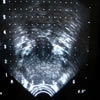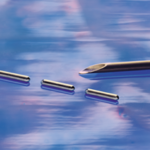Brachytherapy is a form of internal radiation treatment in which small radiation sources about the size of a grain of rice, commonly called seeds, are permanently implanted into the prostate. Brachytherapy utilizes ultrasound imaging to view and guide needles as they accurately place the seeds directly into the prostate.
An Outpatient Procedure
Implantation of the radioactive sources is a minimally invasive procedure, which can be performed in an outpatient setting (does not require a hospital stay). It generally takes about one hour to perform. Either Iodine (I-125) or Palladium (Pd-103) radioactive sources are inserted through the perineum (the area between the scrotum and the anus) into the prostate gland. Dr. Puranik will determine which isotope is most appropriate for your specific condition and, working with your urologist, will implant the radiation sources for maximum benefit to effectively treat the cancer.
Iodine & Palladium Seeds
 These radiation seeds consist of welded titanium capsules containing either I-125 or Pd-103 radioactive material. They feature internal markers that provide high contrast under x-ray for excellent visualization of seed location.
These radiation seeds consist of welded titanium capsules containing either I-125 or Pd-103 radioactive material. They feature internal markers that provide high contrast under x-ray for excellent visualization of seed location.
Iodine I-125 and Palladium Pd-103 have different half-lives and release radiation at different levels. Iodine I-125 radiation seeds have a half-life of approximately 60 days and Palladium Pd-103 has a half-life 17 days. Dr. Puranik will determine the appropriate radiation seed and dosage for you.
Pre-implantation Procedure
 An ultrasound volume study will be performed approximately two weeks prior to surgery to determine the exact size, shape, and location of your prostate. The data collected from this ultrasound study will assist Dr. Puranik in determining how many radiation seeds you require and where they should be placed. At the completion of your ultrasound study, an implantation map, or preplan, for seed placement will be created in our 3D treatment planning software.
An ultrasound volume study will be performed approximately two weeks prior to surgery to determine the exact size, shape, and location of your prostate. The data collected from this ultrasound study will assist Dr. Puranik in determining how many radiation seeds you require and where they should be placed. At the completion of your ultrasound study, an implantation map, or preplan, for seed placement will be created in our 3D treatment planning software.
Implantation
 The preplan, implantation map will be used to accurately place approximately 60-120 seeds into your prostate gland. Seed quantity may vary based on your gland size. You will be placed under spinal or general anesthesia and an ultrasound probe will be inserted into your rectum. The ultrasound probe allows continued visualization of your prostate during the procedure. When visualization is established, a predetermined number of needles will be inserted into your perineum. These needles will be used as a conduit for seed implantation. It is through these needles that the Iodine or Palladium seeds will be permanently implanted.
The preplan, implantation map will be used to accurately place approximately 60-120 seeds into your prostate gland. Seed quantity may vary based on your gland size. You will be placed under spinal or general anesthesia and an ultrasound probe will be inserted into your rectum. The ultrasound probe allows continued visualization of your prostate during the procedure. When visualization is established, a predetermined number of needles will be inserted into your perineum. These needles will be used as a conduit for seed implantation. It is through these needles that the Iodine or Palladium seeds will be permanently implanted.
Recovery
After surgery, you will be taken to the recovery area until the anesthesia wears off. At such time, you may be able to go home with a catheter in place. Post-implantation guidelines to follow will be provided to you that are specific to your case. In general, you will be able to resume eating directly after your release and you will not have to follow any specific diet.
After your implantation you should expect slight bleeding, bruising, and tenderness at your implantation site, as well as bleeding when you urinate. These side effects should subside a few days after your surgery. You may also experience frequent urination, urination urgency, burning when urinating, and a weaker urination stream. Medications can be prescribed to alleviate your symptoms.
Radiation Precautions
While you are undergoing treatment, there are certain precautions you need to take due to the radiation in your body. The following list is a sample of the precautions you may need to take during the first two months following implantation.
- Do not let children sit on your lap
- Avoid prolonged contact with pregnant women closer than six feet
- The first week post-surgery, use a condom during intercourse because you may discharge seeds when you ejaculate
After you have undergone treatment with the brachytherapy seeds, they will remain in your body. Radiation decays over time; the seed will lose their radioactivity after about one year. Though the seeds are designed to remain in place, after implantation some may be carried out of your body through your urine flow. The loss of these seeds should not raise alarm. At IGRT, we use stranded seeds – these are seeds that are encased in a stranded material which prevents seed migration to other parts of the body or within the prostate.

